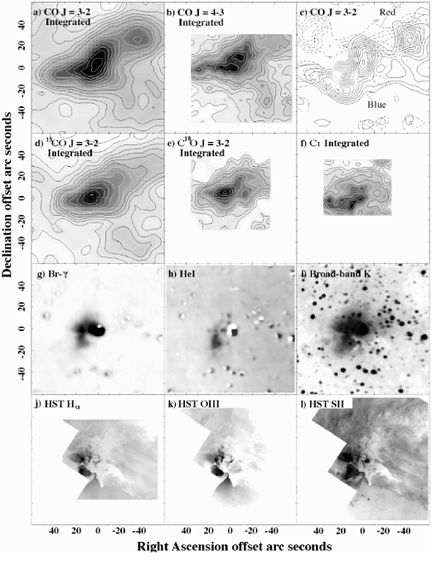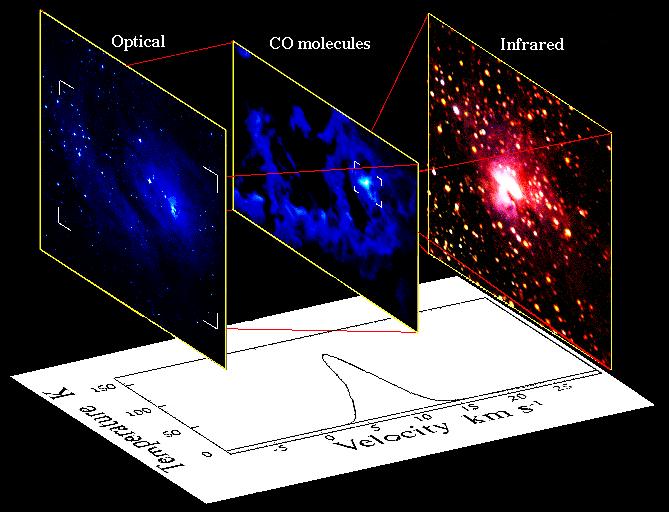|
||||
|
M8 - The Lagoon Nebula M8, the Lagoon Nebula (NGC 6523), is one of the most prominent HII regions in the Galaxy. It has been studied over a wide range of wavelengths. The excitation conditions in the central region of M8 are dominated by the radiation from recently formed OB stars interacting strongly with the surrounding gas, especially the O7V star H 36, which excites the well-known Hourglass Nebula. In this paper, new molecular line maps and narrow-band near-IR images of the H 36 region are reported, and compared with a broad-band 2 micron image and archival HST emission-line images.
The above shows a composite of images we have made of The Lagoon Nebula. Here, the embryonic stirrings of newly forming stars interact with their placental material, producing the exceptionally intense emission.
The Figure above shows optical and infrared pictures of the Lagoon Nebula, and a map of the submillimetre wavelength light of the carbon monoxide (CO) molecule. The bright spot on the CO molecules map shows the location of the region where the new stars are forming. Star Formation is one of the key topics in modern astronomical research, and is fundamentally important as a precursor to the birth of Planetary Systems and the origins of life. The Lagoon Nebula, which lies some 5,000 light years away in the constellation Sagittarius, is a region where stars are currently being born. The optical and infrared radiation shows the location of ionised gas and hot dust, which is illuminated by the light of generations of stars formed millions of years ago. By contrast, the bright spot on the CO molecular image shows just where the new stars are about to be born. The spectrum at the bottom shows the unusually intense CO emission is almost 130 degrees above abolute zero, some 10 times greater than typical of similar star forming regions in our Galaxy. The present day star formation in The Lagoon Nebula occurs inside a dense clump of gas weighing more than 30 times the mass of our Sun, and which has a diameter of about 1 light year. This stellar factory is heated by the radiation from the newly forming star(s), which are just a few thousand years old, and by the nearby hot star Herschel 36, at the centre of The Lagoon Nebula, which is responsible for much of its striking optical appearance. The Lagoon Nebula, and similar objects such as the well known Orion Nebula (the only place known in our Galaxy where CO molecules are found to be hotter, and the radiation is more intense than towards The Lagoon Nebula), are now being studied in great detail to give clues as to how stars are born. The discovery of a source of CO emission this bright came as a total surprise, since this molecule was first detected in space some 27 years ago, and observatories around the world are regularly able to detect it. It's rather like a naked eye astronomer, who previously only was aware of the bright Sun and the much fainter stars, suddenly noticing something new in the sky as bright as the moon. This discovery has been made possible using a submillimetre wavelength telescope, the 15 metre diameter James Clerk Maxwell Telescope in Hawaii. This telescope gives much clearer views of the earliest phases of star formation, and has enabled this important discovery to be made. Studies like this pave the way for the coming generation of sub-millimetre wavelength array telescopes and large infrared wavelength optimised telescopes such as Gemini which will be able to probe more deeply into the material surrounding star formation regions which obscures the escape of optical wavelength emission. This work is based on observations at the James Clerk Maxwell Telscope in Hawaii, the Anglo-Australian Telescope, the ESO/MPG 2.2 m Telescope in Chile and public data retrieved from the HST Archive. The data were collected by a team consisting of Glenn White and Nick Tothill (Queen Mary and Westfield College, London University), Henry Matthews (Joint Astronomy Centre, Hilo and National Research Council of Canada), Bill McCutcheon (University of British Columbia), Monica Huldtgren (Stockholm Observatory) and Mark McCaughrean (MPI fur Radioastronomie, Bonn). |
|
|


